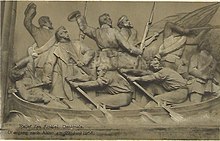Arnkiel memorial
The Arnkiel Memorial was a 21.3 meter high Prussian sandstone monument , which was erected in 1872 on the exact spot in Alsensund where the twenty-fourth regiment landed on June 29, 1864 , coming from Sundewitt before the Battle of Alsen . It was a German memorial in the German-Danish War .
planning
In 1864, after the German-Danish War , Kaiser Wilhelm I suggested that memorials be placed on the battlefield, as in Berlin. The court building officer Heinrich Strack was commissioned to carry out all projects. In 1867, funds totaling 330,000 thalers were approved for this. After about two years of construction, 38,652 and 33,300 thaler respectively had accrued for the Düppel and Arnkiel memorials. For the Victory Column in Berlin, only 258,000 thaler remained.
Emergence
Following a royal decree of December 18, 1864, the foundation stone for the Victory Monument on Arnkiel was laid on April 21, 1865 in the presence of numerous guests of honor. The draft for the monument was created by the Berlin senior building officer Heinrich Strack . The German War delayed the start of construction until 1868. After the founding of the German Empire , the 20 m high monument was completed in August 1871 in the form of a Gothic pinnacle . At the top of from granite and sandstone from Obernkirchen created the monument is a relief medallion of was William I see. The ceremonial unveiling of the victory memorial was carried out on September 30, 1872 by the Prussian government commissioner. A second, very similar victory monument, the so-called Düppel monument , was also made of sandstone by Mayer and Kopp zu Herford.
description
Four statues were set in the monument column:
1. To the west - the Alsensund - a pioneer in the boat
2. To the north, an infantryman waving his cap
3. To the east - towards the forest - a hunter
4. To the south an artilleryman looking towards the entrenchments.
Above the reliefs the epitaph:
"To commemorate those who heroically fell at the crossing of the sea and the conquest of Als on June 29, 1864"
The monument was enclosed with an iron fence.
Whereabouts
Since the transfer of North Schleswig in 1920, the memorial has been in Denmark. In June 1945, a few days after the end of World War II and the German occupation of Denmark , Danes blew up the memorial. The ruins of the Arnkiel monument were buried in a nearby marl pit. A court order prohibited the then and future owners of the pit from ever digging up the rubble.
Individual evidence
- ↑ Reinhard Alings: Monument and Nation: The Image of the Nation State in the Medium Monument - on the Relationship between Nation and State in the German Empire 1871-1918 (Contributions to the History of Communication, Volume 4), De Gruyter; 13. May 1996, ISBN 3110149850 , pp. 89-91
- ↑ North Schleswig - Boundary Drawings and Border Crossings. Monuments and their history in the German-Danish border area (Deutschlandradio Kultur 2014)
Web links
literature
- Inge Adriansen: Erindringssteder i Danmark. Monumenter, mindesmærker og mødesteder , Museum Tusculanum, Copenhagen 2011, ISBN 978-87-635-3173-3 .
- Ferdinand Pflug: The German-Danish War. Rockstuhl, Bad Langensalza 1865/2009, ISBN 978-3-86777-090-3 .
- Gerd Stolz: The German-Danish fateful year 1864. Husum, Husum 2010, ISBN 978-3-89876-499-5 .
- The German Nordmark Ehrenwacht . In: The Gazebo . Volume 44, 1872, pp. 728-730 ( full text [ Wikisource ]).
- Harald Schmid: Memory spaces: images of history and cultures of remembrance in Northern Germany, V&R unipress; Edition: 1 (June 18, 2014), ISBN 3847102435
Coordinates: 54 ° 58 ′ 1.2 " N , 9 ° 45 ′ 36.8" E

